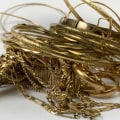Gold ETFs that work like trusts are simple. The trust holds physical gold and issues shares. The shareholder has fractional ownership of that gold. Physically backed gold ETFs seek to track the spot price of gold.
To do this, they physically store ingots, ingots and gold coins in a vault on behalf of investors. Each share is worth a proportionate share of an ounce of gold. The price of the ETF will fluctuate depending on the value of gold in the vault. Gold ETFs are publicly traded and can be bought and sold directly with a Demat account.
Gold ETFs back their assets by purchasing real physical gold with a purity of 99.5%. This physical gold is stored in vaults in the depositary bank and is valued periodically, in accordance with the guidelines of the Securities and Exchange Board of India (Sebi). However, the fund itself maintains gold-backed gold derivative contracts. So, if you invest in a gold ETF, you won't actually own any gold.
With physical gold, counterparty risk may be minimal, as fewer parties are involved. There are you and your gold company. You can participate in every stage of the process, from the purchase to the tracking and receiving of the shipment. Transparency and trust go a long way in mitigating counterparty risk and providing you with peace of mind regarding your purchase.
iShares Gold Trust (IAU) comes from the BlackRock ETF family. If an investor increases the risk on the assets in their portfolio when the price of gold rises, owning a gold ETF can help reduce risk in that position. It is important to understand that a trading price below the tenth of a nominal ounce does not represent a discount in the value of the assets, but rather almost always reflects the reduction in the gold backing of an ETF unit. ETNs are guaranteed debt obligations that don't actually own the underlying gold (unlike ETFs) and have a higher risk of credit default.
It's also a grantor trust, meaning that the gold held in your vault is not traded, leased, or lent under any circumstances. If a given country depends solely on gold as its main source of income, an investor with risky portfolio assets in that country can sell or short sell a gold ETF as protection. In return, the Sponsor covers all the Trust's ordinary fees and expenses, including the trustee, the custodian (responsible for the custody of the Trust's gold bars) and other fees, including printing and shipping costs, legal and auditing fees, etc. This encouraged attempts by innovative companies to find a way to make professional market gold accessible to a new generation of gold bullion investors.
Gold ETFs consist of gold contracts and derivatives and can only be redeemed for cash, never for gold itself. The data on this page tracks the gold held in physical form by fixed equity ETFs and other products, such as fixed-equity funds and mutual funds. Custodians and sub-custodians, usually banks, are responsible for obtaining and storing the physical gold associated with a gold ETF. Gold ETFs “seek to combine flexibility and ease of trading on the stock market with the benefits of physical ownership of gold,” writes the World Gold Council.
However, even without this, gold ETFs are a good way to invest in gold, as investors don't have to worry about the safety and purity of the precious metal. Digital gold currency was an initial attempt, but now, by far, the two most successful approaches are gold ETFs and BullionVault. Or if, after extensive research, an experienced investor decides to short sell gold, trading a reverse gold ETF can be a simple way to benefit from falling gold prices. A fundamental limitation was to keep new buyers away from investments in gold bullion, and this was the form of the commodity that was professionally traded: Good Delivery Bar gold bars.
.



